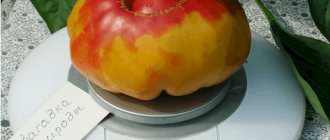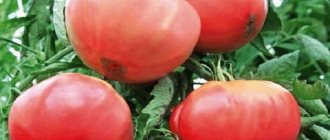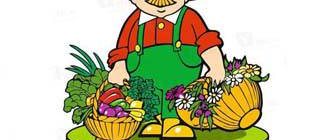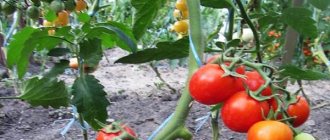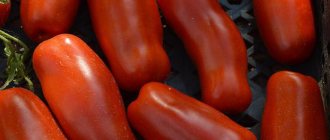Description of tomato Anyuta F1
The bush of the determinate plant is strong, but barely reaches 70 cm in height, and has powerful shoots that are tied up so that they do not bend under the weight of the fruit. There are not very many branches on the Anyuta F1 hybrid; they are covered with leaves of the usual green shade.
Ripe fruits differ:
- bright red color;
- thick skin;
- rounded shape;
Tomatoes weigh at least 100 g, do not crack when canned, are suitable for making juice, pickling, used in salads, and added to borscht.
5 clusters are formed on the bush, and up to 6 fruits are tied on each.
Features of cultivation
The Anyuta F1 hybrid is not too demanding on the soil composition, however, when picking, planting on ridges and during the growing season, fertilizing with complex mineral fertilizers is necessary. Gardeners can replace chemical fertilizing by introducing wood ash, an infusion of bird droppings, or a fermented infusion of finely chopped weeds into the soil. Foliar feeding will also show good results, for example, spraying the bush with an infusion of onion peels and citrus peels.
When choosing hybrids such as “Anyuta F1” for planting on your plot, even the absence of a greenhouse will not be an obstacle to getting a decent tomato harvest.
In the table below you will find links to tomato varieties with different ripening periods:
| Early ripening | Mid-season | Mid-late |
| White filling | Ilya Muromets | Black truffle |
| Alenka | Wonder of the world | Timofey F1 |
| Debut | Biysk rose | Ivanych F1 |
| Boni M | Bendrick's Cream | Bullet |
| Room surprise | Perseus | Russian soul |
| Anyuta F1 | Yellow giant | Giant red |
| Solerosso F1 | Blizzard | New from Transnistria |
Characteristics of the variety
Anya, as summer residents affectionately call the tomato, grows on black soil, loam, and sandy loam soils. The hybrid has good immunity to fungi and viruses, and practically does not suffer from:
- from late blight;
- tobacco mosaic;
- fruit cracking;
- top rot.
80 days after planting the tomatoes, the tomatoes ripen; thanks to their thick skin, they do not lose their presentation during transportation and are stored without processing for up to a month. Productivity - from 2 to 3 kg of fruits per bush.
Disease and pest control
Anyuta F1 tomatoes are resistant to most diseases, but it is not recommended to ignore preventive treatment, especially during periods of virus activation.
Infection with viral diseases occurs during the first 20-30 days after planting seedlings in open ground. It is at this time - the end of May - June that insect carriers are most active. But the incubation (hidden) period of viral diseases is about a month. That is, the tomato plant is already infected, but the symptoms of the disease will not appear soon.
To do this, use preparations made on the basis of chemical or biological substances (fungicides “Barrier”, “Barrier”, Bordeaux mixture, etc.).
Traditional methods also remain popular: spraying plants with garlic infusions, ash water, hydrogen peroxide solution, etc.
Additionally, you must adhere to the following rules:
- water as needed, avoiding waterlogging of the soil;
- regularly loosen the soil between the bushes, remove weeds, thin out dense foliage;
- when growing in greenhouses, ventilate them daily;
- apply fertilizers in a timely manner.
In order to protect against pests, the bushes are sprinkled with dry ash, tobacco powder, and sprayed with infusions of St. John's wort, wormwood, onion, and garlic.
Advantages and disadvantages of a hybrid
Gardeners who grow tomatoes only regret that they cannot collect seeds from the fruit and have to buy them every time. But this is perhaps the only drawback of the hybrid, but there are many advantages, which include:
- Unpretentious to care and soil.
- Fast ripening of fruits.
- The presence of immunity to disease.
- Long shelf life of tomatoes.
Some summer residents say that the Anna tomato variety is sour for them, and when preparing the juice they add sugar. But after heat treatment, the skin does not crack, the fruits are excellent for rolling into jars.
Area of application of fruits
The fruits of the “Anyuta” f1 tomato are stored for a long time without losing their gastronomic qualities. They are well transported to the place of sale. They supply tomatoes to retail outlets, restaurants and catering facilities. Eat fresh and make salads. In homemade preparations they are used for making juice, pickling, and canning.
Resistance to diseases and pests
Hybrid tomato "Anyuta f1" has good immunity against common nightshade infections. The variety is not affected by: macrosporiosis, a type of fruit and root rot, mosaic, fruit cracking. Possible late blight. Among the insects that parasitize the crop are nematodes, larvae of the Colorado potato beetle and whitefly moth, and less commonly, spider mites.
Advantages and disadvantages of the variety
Hybrid tomato species rarely have serious deficiencies. During experimental cultivation, breeders eliminate the shortcomings of the variety. The conditional disadvantages of the “Anyuta” f1 tomato include average resistance to pests and the need for sufficient lighting. Excess or deficiency of moisture is not relevant for tomatoes.
According to vegetable growers, Anyuta f1 tomatoes (pictured) are characterized by a number of advantages:
- grown in open ground and protected structures;
- good taste and aesthetic presentation;
- the variety reaches biological ripeness at the beginning of summer;
- Two crops are harvested per season;
- tomato is undemanding to watering;
- resists diseases well;
- The fruits are of a convenient size, suitable for preservation.
A universal tomato.
Growing Tomato Anyuta
To get up to 3 tomato harvests over the summer, hybrid seeds are sown starting in February and ending in May. If the weather is favorable, you can enjoy the first fruits in June and collect tomatoes until October.
See also
Description of the Butterfly tomato and features of growing the variety
Read
Planting seeds
A drainage layer is poured into a container or box and filled with a substrate made from peat, garden soil, sand, humus with the addition of perlite. Make grooves in the soil and place Anyuta tomato seeds at a depth of 8 mm; the distance between each grain should not exceed 2 cm. The box is covered with film and left warm, ventilated regularly.
Growing and caring for seedlings
The seedlings are watered, fed with an ash solution, and when sprouts appear, the container is moved to a window in a room where the film is removed from 18 to 20 °C. When 2 leaves appear, the seedlings are planted in separate pots, 2 bushes in each, at a distance of 10 mm.
When the young plants take root, a small cut is made on the stems, joined together, and tied with film or bandage at the point of damage. Before moving to the garden, the tomatoes are hardened by taking them out into the fresh air.
Transplanting seedlings into open ground
An area for tomatoes should not be planted where eggplants or potatoes grew last season. Nightshade crops attract Colorado potato beetles and suffer from the same infection.
When digging up the soil, organic matter is added in the fall, and mineral fertilizers superphosphate, potassium salt, and ammonium sulfate are poured into each hole in the spring. There are 6 tomatoes per square meter.
When planting double bushes, they get rid of the weak top. Such tomatoes develop better and delight with a large number of fruits.
Description of the tomato variety
The crop was bred for cultivation in the unprotected territory of the Rostov region, North Caucasus district, Stavropol and Krasnodar territories. In the central part of Russia, cultivation in a greenhouse is possible. Tomato “Anyuta” f1 (pictured), according to the copyright holder’s description, belongs to the ultra-early varieties. In warm climates, two harvests can be harvested per season. Ripening time: within 3 months from the moment of sowing the seeds. The first collection occurs in June. Replanted tomatoes ripen in late August - early September.
The tomato variety “Anyuta” f1 is a determinate species; the crop does not grow higher than 65 cm. The bush is standard, producing a minimum number of side shoots. Characteristics of tomatoes “Anyuta” f1:
- The plant does not require additional bush formation; the tomato is formed by one central trunk. The main stem is thick, woody, and light green in color. Easily withstands the weight of the fruit. The plant does not require fixation.
- The culture produces few shoots; they are used to form a crown; the color of the shoots is light green.
- The variety is intensely leafy, the leaves are medium-sized, oblong with carved edges and a slightly corrugated surface. Slightly pubescent.
- The tomato blooms with yellow self-pollinating flowers that produce 100% fruit.
- The bush forms 5 brushes every three leaves. The average density of each is 6 tomatoes. The filling capacity does not change; the weight of the fruits of the last circle will be lower than the first.
- The root system of the tomato “Anyuta” f1 fully nourishes the plant and ensures stability.
Description of fruits
According to reviews from vegetable growers, “Anyuta” f1 tomatoes ripen unevenly and have different weights. Description of the fruit of the variety:
- diameter about 7 cm, weight from 60 to 120 g, round shape, slightly pressed on top;
- the peel is thin, bright red, a dark yellow pigment is visible near the stalk at the ripening stage;
- the surface of the tomato is glossy, without ribbing, does not crack;
- The variety produces few seeds, they are located in 5 sections, planting material is not suitable for breeding the next generation of the crop;
- The pulp has a dense consistency, juicy, no voids, and at the stage of technical ripeness there are white fragments.
Advice!
The ultra-early variety is rarely used for winter harvesting, but the second harvest tomato “Anyuta” f1 is suitable for canning. Tomatoes have a sweet taste, the ratio of glucose to acid is 3:1.
Plant care rules
It is easier to care for the compact hybrid Anyuta in the garden than for tall tomatoes. Care involves:
- hydration;
- fertilizer;
- loosening the earth;
- weeding from weeds.
To make tomatoes bear fruit longer, the bushes are sprayed with a solution prepared from a liter of milk and 30 drops of iodine.
Watering
In the southern regions, where summers are dry and hot, tomatoes need irrigation. Once or twice a week, about 5 liters of water heated in the sun are poured under each bush, the soil is loosened, and the plants are hilled up.
See also
Characteristics of the Snow White tomato variety, cultivation and care of bushes
Read
Top dressing
10–14 days after planting tomatoes, they resort to fertilizer. To do this, take 1 kg of mullein, 20 g of superphosphate and a bucket of liquid. Tomatoes react positively to feeding with mineral complexes, ash and solutions of fermented grass.
The bushes are fertilized several times during the summer, always before flowering and ovary formation. Although the tomatoes are not tall, the stem is attached to a support, and when lateral layers appear, they are pruned. In the south, these shoots are planted in the ground, and a full-fledged bush grows from them.
Pest protection
Tomato leaves attract whiteflies, spider mites, aphids, and the Colorado potato beetle. In order to prevent an insect resembling a moth from destroying the tomatoes, the ground near the bushes is sprinkled with ash, tobacco dust, and the plants are sprayed with quicklime. When a pest appears, tomatoes are treated with Confidor or Fitoverm.
To combat spider mites, use “Karbofos” or prepare an infusion of dandelion and garlic. To cope with the Colorado potato beetle and aphids, insecticides “Iskra” and “Aktara” are used.
Diseases and their prevention
The hybrid tomato Anyuta does not suffer from root rot and mosaic, and is resistant to cladosporiosis. To prevent the appearance of other diseases, follow the rules of agricultural technology, spray the bushes with Bordeaux mixture or purchased fungicides.
Collection and storage
The first tomatoes are picked in June and put in salads and eaten fresh. Fruits that ripen in autumn are used for canning, making juice, sauces, pickling and salting. In a cool place they do not spoil for a whole month.
Care
Plants need good care
Rational care of Anyuta F1 tomatoes will allow you to get the maximum amount of high-quality fruits with high commercial characteristics. For this:
- Watering is carried out as needed, adding warm water exclusively to the root. Sprinkling can lead to shedding of flower stalks and ovaries, and cracking of fruits. It is advisable to water the crop in the morning or evening;
- After watering, the soil between the tomato bushes needs to be loosened. This will improve air exchange in the soil and prevent the rapid evaporation of moisture. When adventitious roots appear on the soil surface, it is necessary to hill up the bushes;
- For fertilizing, the following solutions are used: add 1 tbsp to 10 liters of water. l. the “Ideal” drug and nitrophoska (500 ml of fertilizer is applied to each bush 2-3 weeks after transplanting the seedlings). Bird droppings are used as organic fertilizers (water and fertilizer in equal proportions are infused for 3-4 days and the concentrate is diluted with water in a ratio of 1:15). Apply 2-3 liters of solution under one bush. For foliar feeding, use ash water or urea solution (2 tablespoons of substance per 10 liters of water);
- The compact tomato bush Anyuta does not require formation, but does need regular pinching. It is also necessary to periodically remove the lower leaves on the plant. If there are a large number of ovaries, it is recommended to tie the stem and brushes of the crop to a support.
Reviews
According to summer residents, this crop is worthy of the attention of not only experienced, but also novice gardeners:
- the variety is characterized by good productivity, small-sized fruits have good taste, marketability, do not crack and are suitable for universal consumption;
- thanks to the high immunity against various Solanaceae diseases, you can get an environmentally friendly harvest without the use of pesticides;
- Caring for tomatoes is simple - they do not require shaping or garter.
History of selection and region of growth
Tomato Anyuta and “Partner” are a modern hybrid of the first generation. Entered into the state register in 2005. Recommended for garden plots in the North Caucasus region, which includes:
- republics - Crimea, Adygea, Dagestan, Chechen, Ingush, Kabardino-Balkaria, North Ossetia-Alania;
- Krasnodar and Stavropol territories;
- Rostov region.
When breeding the variety, the effect of heterosis was used - an explosive increase in the productivity of the first generation. The yield of such hybrids is 20-30% higher than the parent.
Seeds of heterotic hybrids cannot be independently collected from fruits for sowing the next year - the plants that emerge from them do not retain typical parental characteristics.
Harvesting and application
This early ripening variety bears fruit twice per season. The first vegetables are harvested from the end of June. The second harvest occurs in mid-August and, in warm weather, continues for another month.
Farmers saw material benefits in double harvesting, and the variety began to be successfully used for commercial purposes. In addition, vegetables have a long shelf life, which allows them to be transported over long distances. The shelf life of fresh vegetables is up to 30 days.
In cooking, tomatoes look good in salads, ideally complementing other vegetables. The autumn harvest is suitable for canning, pickling, and twisting. They also prepare other tomato products: ketchups, juices, pastes - in winter, such a solution looks good on any table.
And yet, the main merit of the culture remains the long-term storage of fresh vegetables without loss of gastronomic properties.
Growing seedlings
The seedling growing method is suitable for this variety. Seeds are sown on March 20-30.
High quality seed material is one of the main rules for the successful cultivation of this crop. Buy fresh seeds with a current expiration date from the originator - Semko Junior or Partner.
Before sowing, suitable seeds must be discarded - the contents of the bag are poured into salt water for 15 minutes. The seeds that have sunk to the bottom are removed, washed, and immersed in a strong solution of potassium permanganate (it will destroy all pathogenic bacteria). After this, soak in a solution of Epin or Zircon for 6 hours, then dry and place in the refrigerator for a day.
It is better to sow tomatoes in light, loose and fertile soil. There are two options:
- buy a ready-made substrate for growing vegetable seedlings;
- prepare it yourself - mix garden soil with compost (humus), sawdust steamed with boiling water, peat and sand in a ratio of 2:2:1:1:1.
Homemade soil mixture must be calcined in the oven.
Sowing technique
For sowing, different containers are used - seedling boxes, cassettes, plastic containers or peat tablets. The main thing is that the container is at least 10 cm high and has drainage holes at the bottom.
The container is filled halfway with the substrate, the seeds are deepened by 1.5-2 cm. They are planted at a distance of 3-4 cm, sprinkled with a thin layer of soil mixture, irrigated with warm water, and covered with transparent material to create a greenhouse effect.
Care
For successful seed germination, several conditions must be met:
- place the container on a warm windowsill, where the temperature is between 23-25°C and there is diffuse daylight for 10 hours a day;
- The seedlings also need to be ventilated every day to prevent the soil from becoming moldy - 30 minutes is enough;
- Irrigation with warm water as the soil dries.
After about 10-14 days, greenery will appear on the surface of the substrate. Then you can remove the shelter and continue to water periodically. When the sprouts reach 2-3 cm in length, it is necessary to lower the temperature to 16-18°C so that they do not stretch.
Picking
When germinating in groups, seedlings should be planted, otherwise they will quickly wither in crowded conditions. This procedure is carried out early in the morning at the stage of appearance of 4-5 leaves.
First, the seedlings are watered abundantly, then transplanted individually into disposable containers - plastic cups. Add soil, compact it, and pour in a solution of urea - 15 g per 10 liters of water. 50 ml of working liquid is poured under each seedling. This fertilizer will help them quickly take root and grow.
How and when to transplant to a permanent place
Typically, seedlings are transplanted 50-60 days after emergence. By this time it will reach a height of 25-30 cm, grow roots and foliage. The procedure is carried out at the end of May or at the beginning of June.
Tomatoes grown on a windowsill are very sensitive to sunlight and fresh air, so before planting they need to be hardened off - taken outside daily and kept for 2-3 hours.
Select an area well lit by the sun with light, loose, slightly acidic soil. The best predecessors of tomatoes are cabbage, carrots, beets, onions, and pumpkin crops.
The place is prepared in the fall - a bucket of leaf compost or humus, wood ash (3 kg), potassium sulfate (50 g) and superphosphate (100 g) are added to 1 m² and dug up. 10 days before planting, the bed is watered with a urea solution to destroy all pathogenic bacteria.
Holes are dug according to a 60x50 cm pattern; 4-5 bushes are enough per 1 m². Water them with water, then lower the bushes, sprinkle them with soil, compact them, moisten them again, and mulch them with garden soil.
Planting and care
The Anyuta tomato is a hybrid, so only seeds purchased in specialized stores can be sown for seedlings.
Sowing seeds for seedlings
The sowing of tomatoes of the ultra-early variety Anyuta begins in early March. The seed planting process is standard:
- The soil mixture is collected from humus and peat (ratio 1:2).
- The seed material is soaked in a growth stimulator (Virtan-Micro, Epin), then dried and placed in the refrigerator for 24 hours.
- In containers with soil mixture, make furrows 1.5-2 cm deep and sow seeds.
- The furrows are covered with earth and the soil is slightly moistened.
The containers are covered with transparent material (glass, polyethylene) and placed in a warm place. When the first shoots appear, the covering material is removed.
Picking and transplanting seedlings
As soon as 2-3 leaves grow on the seedlings, they are planted in separate containers. A suitable option is peat cups, which will also serve as top dressing when planting seedlings in the garden.
Expert opinion
Stanislav Pavlovich
Gardener with 17 years of experience and our expert
Ask a Question
Important! If the planting material was initially sown in separate containers, then the seedlings are not picked.
12-15 days before transplanting the seedlings into open ground, hardening of the Anyuta tomato begins - the containers are taken out into the open air. The hardening time is increased gradually, but before planting in open ground, the seedlings should be outside for the whole day. Seedlings with 5 leaves are planted in the beds (around the beginning of May).
The Anyuta hybrid is determinant, so the holes for seedlings can be arranged in a checkerboard pattern, maintaining a distance of 30-45 cm between the rows. Row spacing is made 60-70 cm wide. In the same order, seedlings can be planted in a greenhouse.
Watering and fertilizing
The beds for tomatoes begin to be prepared in the fall - the soil is dug up and fertilized with organic matter. In spring, complex mineral additives are added to the soil.
Fertilizing is applied for the first time 17-20 days after planting the seedlings. Use a mixture of the drug “Ideal” and nitrophoska (a tablespoon of each substance is diluted in 10 liters of water). 0.5 liters of solution is poured around each seedling.
The second feeding is carried out on already flowering tomatoes Anyuta. You can use the ready-made mineral mixture “Signor Tomato”. After 15-20 days, the plants are fertilized with a superphosphate solution (a tablespoon of granules is diluted in a 10-liter bucket of water).
Plants begin to be watered 2-3 days after transplantation. Before flowering, the bushes are watered infrequently, but the soil is not allowed to dry out. As soon as the fruits set, the volume of watering is increased.
Formation
The Anyuta hybrid bush forms one trunk and a small number of shoots, so the plant is not pruned. Experienced gardeners use a new technology: two seedlings are planted in a hole and, as soon as the plants become stronger, they are combined. To do this, vertical cuts are made on the trunks and the seedlings are tightly wrapped.
See also Description and subtleties of growing tomato Striped chocolate
After the plants grow together, the larger trunk is left and the second is cut off. In this way, a bush is formed with a doubled root system, which has a positive effect on productivity.
Loosening the soil and removing weeds
After moistening, the area must be loosened in order to retain soil moisture longer. Dense soils must be loosened before watering so that the moisture is evenly distributed throughout the bed.
Advice! If plant roots are exposed during irrigation, the bushes should be lightly covered with soil.
After irrigation, the soil becomes compacted and becomes crusty. Thanks to loosening, the crust breaks up and air access to the tomato root system improves. It is advisable to combine loosening the soil with the removal of weeds, which are easier to pull out with their roots from wet soil. The pulled out weeds are not left in the beds to prevent pests from appearing.
Pest and disease control
The early hybrid Anyuta is little susceptible to disease. For preventive purposes, it is recommended to use copper sulfate to treat tomato beds. In gardens located in warm regions, you can harvest two crops of tomatoes. When re-sown, plants may become susceptible to late blight. If this happens, it is recommended to remove the affected parts from the bushes and irrigate the beds with Bordeaux mixture or Fitosporin.
Plantings are treated against pests with special planting agents. When tomato bushes are infected with whitefly, the underside of the foliage is sprayed with Fitoverm. When spider mites appear, use “Karbofos” and “Anti-mite”.
How to grow seedlings
Sowing of seeds begins in the last ten days of March. But the specific timing is influenced by the climatic features of the region.
Before planting, seeds are determined for suitability by placing them in a saline solution. To do this, dissolve 1 teaspoon of salt in a glass of water. Floated seeds are not suitable for sowing. The rest are washed well in clean water. Soaking seeds in a growth stimulant increases germination. To germinate the grains, they are placed in a damp cloth for 1-3 days.
Reference! Seeds for planting next year should not be selected from the hybrid variety yourself. This will not give any result. Purchase planting material from specialized stores.
After the first shoots appear, the seeds are planted in prepared soil. A mixture of peat and humus at a ratio of 2:1 is suitable. You can sow seeds in wooden boxes, plastic glasses, peat pots. A thin layer of drainage from small pebbles or wood shavings and soil are poured into the containers.
The soil is moistened and the sprouted grains in a damp cloth are placed in shallow (up to 2 cm) holes. After sowing, the soil is leveled from above and watered with water with the addition of growth stimulants. After which the containers are covered with film.
The containers remain in a lighted room where the air temperature is at least +23C. When shoots appear, the film is removed and complex fertilizers are applied.
Picking of seedlings is carried out after the appearance of three true leaves. If the seeds were sown in individual containers, picking is not required.
2 weeks before planting young bushes in open ground, the seedlings begin to harden off. The hardening process comes down to keeping the seedlings in the open air for a certain time: from 1-2 hours to 1 day. At night, the seedlings are removed to a room where the air temperature is no more than +13C.
Advice! Before planting tomatoes in the garden, young plants must withstand being outdoors for at least 14 hours.
Features of the variety
The Russian hybrid Anyuta is an ultra-early tomato variety for growing in open ground. The first harvest can be harvested within 86-94 days after sowing the seeds.
Grapes Anyuta
Some farmers, thanks to this speed of ripening, even manage to get a double harvest. If you sow the seeds at the end of March, you can harvest the crop in June. You can plant seeds for seedlings a second time at the beginning of May, so that by the end of August you can get a harvest again.
Interesting fact. If weather conditions permit, fruiting of the Annushka tomato variety can last until the end of September.
The Anna tomato plant has determinant characteristics and is characterized by low growth (65-70 cm). Leaves on tomato branches are located in sufficient quantities. The foliage shape is traditional for this crop; it is green.
The first inflorescences that will bear fruit begin to form on the 6-7th leaf. Then the formation of the next ones occurs after 1-2 sheets.
Fruit
Tomato Annushka f1 has medium-sized fruits (about 110-120 g). The peel is dense, round in shape. The taste is simply excellent for a hybrid. Most often, about 6-7 pieces are formed on one brush.
Fruit
Another advantage of this variety is its versatility. Tomatoes are used with equal success for fresh consumption, as well as for canning and processing. The big advantage of the fruits is that they do not crack. With proper agricultural technology, you can get up to 8-9 kg from each square.
Similar varieties
Several more varieties deserve attention, which according to their characteristics are suitable for obtaining an early harvest.
Anna Rushen
The mid-early variety belongs to the semi-determinate species. On bushes up to one and a half meters high, fruits weighing about 300 g ripen. Pink-red tomatoes are distinguished by their heart-shaped shape. Juicy tomatoes have a sweetish taste, practically no seeds, and are used for making juices and fresh salads.
Annetta
The indeterminate variety is a mid-early variety. The bushes grow to a height of 1.8-3 m, so the plants must be constantly monitored. Round-shaped tomatoes ripen weighing 100-180 g, are easily transported and stored. Tomatoes are suitable for salads and canning. Annette's advantages are drought and cold resistance, but it will not be possible to harvest twice in a season.

